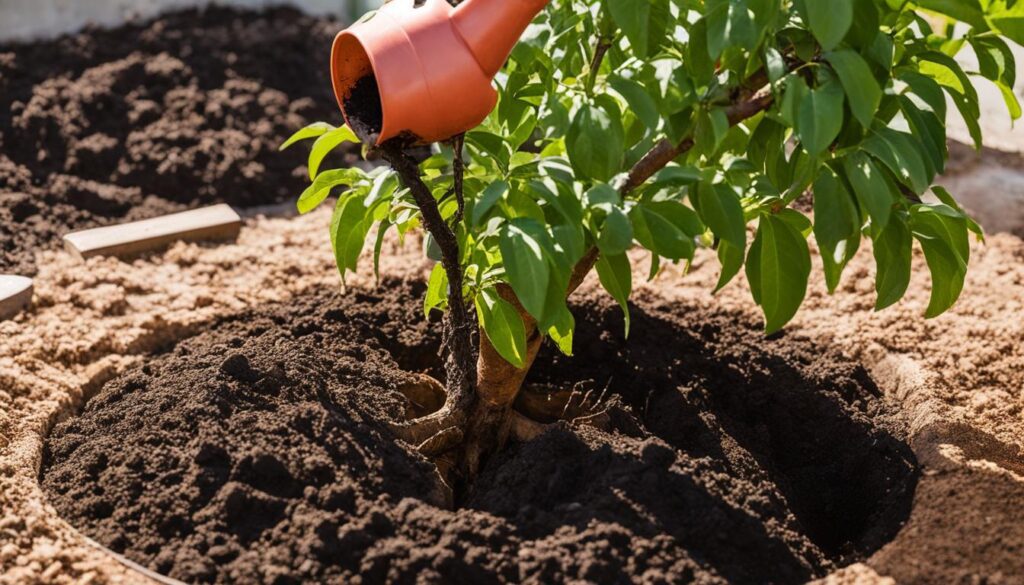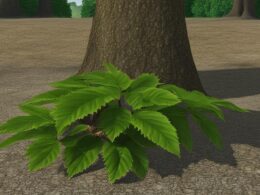Welcome to our Bonfire Patio Peach Tree Care & Growth Guide. If you’re looking to add a beautiful and fruitful tree to your outdoor space, the Bonfire Patio Peach Tree is an excellent choice. In this guide, we’ll provide you with all the necessary information to ensure the health and prosperity of your tree.
The first step in caring for your Bonfire Patio Peach Tree is to select the right location. Choose an area with well-draining soil that receives at least six hours of sunlight each day. This tree thrives in full sun, so ensure it has ample exposure to promote healthy growth and fruit production.
Once you’ve found the perfect spot, it’s time to plant your tree. Dig a hole as deep as the root ball and twice as wide, amending the soil with compost or manure for added nutrients. After removing the sapling from its pot, gently untangle any encircling roots and place it in the hole. Fill the hole with soil, firmly pressing it around the base of the tree. Water thoroughly, and add a layer of organic mulch to conserve moisture and deter weeds.
To support the growth of your Bonfire Patio Peach Tree, proper watering is essential. Check the moisture level of the soil about 2 inches below the surface and water when it feels dry. Aim to keep the soil consistently moist but not waterlogged to avoid root rot. Remember to fertilize with a balanced formula in early spring and throughout the growing season to provide essential nutrients for vigorous growth.
The Bonfire Patio Peach Tree is self-pollinating, but planting more than one can enhance the harvest. Bees are the primary pollinators for this tree, but you can also hand-pollinate with a small brush if necessary. Pruning should be done in early spring to shape the tree and remove any damaged or diseased branches. Regularly monitor your tree for pests and diseases, such as the peach tree borer and peach tree leaf curl, and take appropriate measures to control them.
When it’s time to harvest, wait for the small peaches to become soft and change color. These fruits are perfect for culinary creations like pies and preserves. If you prefer to grow your Bonfire Patio Peach Tree in containers, ensure they have proper drainage, and provide regular fertilizing to support healthy growth.
Follow our comprehensive guide, and your Bonfire Patio Peach Tree will reward you with abundant harvests and stunning beauty. Cheers to successful peach tree growing!
Planting and Watering the Bonfire Patio Peach Tree
Proper planting and watering are crucial for the healthy growth of your Bonfire Patio Peach Tree. Follow these steps to ensure success:
- Choose the right location: Plant your Bonfire Patio Peach Tree in an area with well-draining soil and at least six hours of sunlight each day. This tree thrives in full sun, so choose a spot that receives ample sunlight.
- Prepare the soil: Before planting, dig a hole that is as deep as the root ball and twice as wide. Add compost or manure to the soil to improve its fertility and drainage.
- Remove the sapling from its pot: Carefully unpot the sapling and gently loosen the roots. Remove any encircling roots to prevent them from strangling the tree’s growth.
- Water thoroughly: After planting the tree in the prepared hole, water it thoroughly to settle the soil and hydrate the roots. Ensure that the water reaches deep into the soil.
- Apply organic mulch: Spread a layer of organic mulch around the root zone of the tree. This helps conserve moisture, regulate soil temperature, and suppress weed growth. Keep the mulch a few inches away from the trunk to prevent rot.
- Maintain proper moisture: Check the soil’s moisture level regularly by inserting your finger about 2 inches below the surface. If the soil feels dry, water the tree deeply and evenly. Avoid overwatering, as it can lead to root rot.
- Fertilize adequately: Feed your Bonfire Patio Peach Tree with a balanced fertilizer formulated for fruit trees. Follow the package instructions for application rates and timings. Fertilize in early spring and throughout the growing season to promote vigorous growth and abundant fruit production.
Following these planting and watering guidelines will set your Bonfire Patio Peach Tree on the path to thriving and producing delicious fruit.
Pollination, Pruning, and Pest Control
When it comes to the Bonfire Patio Peach Tree, pollination is a crucial factor in achieving a successful harvest. This delightful tree is monoecious, meaning it has both male and female parts on the same tree. While one tree is sufficient for fruit production, planting additional trees can increase the harvest even further.
Nature’s little helpers, bees, are the primary pollinators for the Bonfire Patio Peach Tree. However, if you want to take matters into your own hands, you can also perform hand-pollination using a small brush. This ensures that every blossom receives the necessary pollen for optimal fruit set.
Pruning is an essential aspect of maintaining the health and shape of your Bonfire Patio Peach Tree. It is recommended to prune the tree in early spring. This allows you to remove any damaged or rubbing branches and promote proper air circulation. A well-pruned tree not only looks beautiful but also helps prevent the spread of diseases.
Pests and diseases can pose a threat to the Bonfire Patio Peach Tree’s growth and fruit production. Keep a vigilant eye out for the infamous peach tree borer and the dreaded peach tree leaf curl. To control these pests, you can use an insecticidal spray containing permethrin on affected trees. For fungal diseases, applying a copper fungicide can help treat the infected areas. Regular inspections and timely intervention will ensure the health and longevity of your tree.
Can the Care and Growth Guide for Wandering Jew Plants be Applied to Bonfire Patio Peach Trees?
Yes, the care and growth guide for growing wandering jew plant outdoors can be applied to Bonfire Patio Peach Trees. Both plants require well-draining soil, ample sunlight, and regular watering. Additionally, they benefit from occasional pruning to promote healthy growth and beautiful foliage.










